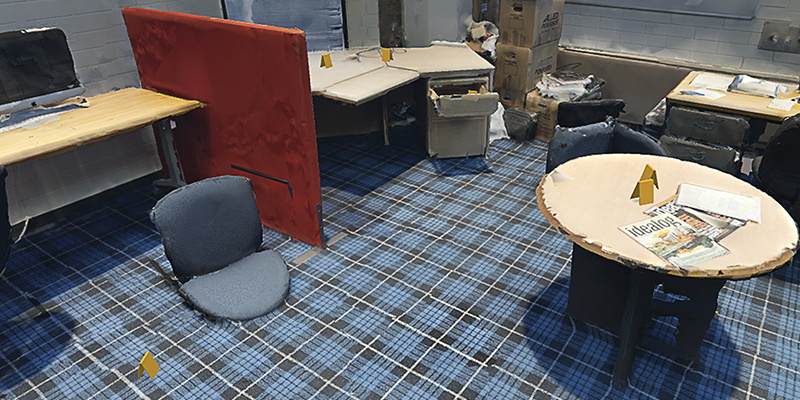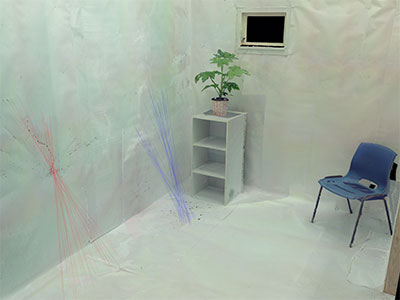The technology to take a jury into a 3D crime scene
By Candy Gibson
 TECHNOLOGY AND ENGINEERING A virtual reality (VR) crime scene … the scene of a break-in reconstructed in virtual reality.
TECHNOLOGY AND ENGINEERING A virtual reality (VR) crime scene … the scene of a break-in reconstructed in virtual reality.How often do jurors get it right? Studies show that juries and judges reach the same verdict in about 80 per cent of cases but that doesn’t mean that both parties are always correct.
The legal minefield that ordinary men and women must navigate in even the simplest of court cases is a burden of its own, not to mention the huge responsibility that jurors have to the person accused.
Is there a way to simplify the process and improve the accuracy of verdicts? There could be, by virtually reconstructing crime scenes, particularly in cases where spatial awareness is critical.
A new project led by UniSA PhD candidate Carolin Reichherzer explores the use of a reconstructed 3D model of a crime scene viewed in a virtual reality (VR) headset, comparing its effectiveness with photographs and actual site visits.
Working in conjunction with police, forensic and legal experts from Australia and New Zealand, Reichherzer and her team recruited volunteers for a pilot study to determine the pros and cons of VR in a court setting.
Participants trialled the three different viewing options and were also given a written narrative of events, including spatial locations of stolen goods.
The results showed that VR is a far more reliable tool for spatial memory compared to photographs, but not as good as an actual site visit.
While jury visits to crime scenes are the “gold standard” in providing juries with a realistic impression, they too have their failings, Reichherzer says.
“Firstly, they can be very expensive, particularly where the crime scenes are in remote locations. In some cases, the scene has also been altered, demolished or is inaccessible, which can make viewings impossible.”
Car crash evidence, for example, is often very short-lived due to changing weather conditions.
The results of the pilot study showed that spatial knowledge in a VR environment is patchy but could offer a compromise where actual site visits are prohibitive.
 An upcoming experiment aimed at understanding expert statements in VR
An upcoming experiment aimed at understanding expert statements in VR“Virtual reconstructions appear to be more reliable than oral presentations, sketches, photographs and videos – all traditional forms of evidence,” Reichherzer says.
“Currently, the trial process does not provide a natural way for the jury to make sense of the evidence. It is often presented in a disconnected fashion, out of chronological or spatial order and each jury member must create their own mental representation of what they believe happened.
“When you consider that the average attention span of a juror is less than seven minutes, and that much of that time they are taking in complex information, it can leave them feeling overwhelmed and frustrated.”
Using a 3D virtual reality headset allows jurors to feel they are physically present in a location and to work out how certain events can happen in each space. Moreover, VR can include evidence and other information that has been removed by the time a jury viewing can occur, Reichherzer says.
“This could potentially help the jury reach a verdict faster and more accurately.”
Reichherzer and her colleagues plan to undertake more experiments to improve the accuracy of VR technology.
This will include making the scenes more complex, tying the spatiality of the crime scene more tightly with the narrative, and using laser scanners.
Volunteers are needed for the next round of VR experiments. Please contact Carolin.Reichherzer@unisa.edu.au if you are interested in taking part.
Reichherzer is based in the Australian Research Centre for Interactive and Virtual Environments (IVE) at UniSA’s Mawson Lakes campus. Her PhD project is being supervised by Professor Bruce Thomas.
The results of the pilot study are published in an article co-authored by Reichherzer, Narrative and Spatial Memory for Jury Viewings in a Reconstructed Virtual Environment
Other Stories
- Painless needles on the way for vaccinations
- Hi. How can I help you? Health clinic embraces the robot age
- Virtual health coach ‘Paola’ will help you get fit and eat well
- Carbon-free renewable energy solution to ‘heat up’ industry
- From the Vice Chancellor
- Achievements and Announcements
- The technology to take a jury into a 3D crime scene
- Oscars 2019 plays it safe with Green Book, lacks enlightened thinking
- Organ-on-a-chip technology to reduce side effects of radiotherapy
- Find out about UniSA’s dedicated student support services (Video)
- International defence research lab with France planned for Adelaide
- New innovation hub in Whyalla to nurture regional startups
- The latest books from UniSA researchers
- In Pictures




